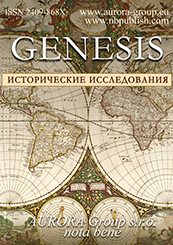Ethnography and ethnology
Reference:
Ilikaev, A. (2024). The problem of the authenticity and divine status of the image of heavenly virgins in Mari mythology. Genesis: Historical research, 11, 1–11. . https://doi.org/10.25136/2409-868X.2024.11.72216
Abstract:
The subject of this article is the question of the authenticity, as well as the divine status of celestial maidens in Mari mythology. The images of celestial maidens (for example, Yumyndyr – the Daughter of Heaven/ God) in Mari mythology are archetypal. In addition, images of celestial maidens are found in the mythology of the Finns, Karelians, Komi and Mordvins. So, Komi is the famous daughter of the sun Zaran, Mordvins – Castorgo and Vecorgo, the daughters of the goddess Ange-Patiai. Among the heavenly maidens, in addition to Yumyndyr, Mari can be noted Piambar, Yymyndyr, Yuktalche, Pampalche, etc. Nevertheless, some researchers doubt the authenticity of the image of Yumyndyr in view of the fact that it is supposedly the only proper mythological image in Mari mythology. However, Mari still has a real myth about Piambar, the daughter of Kugo Yumo. In addition, images of celestial maidens are present in many Mari fairy tales, songs, and spells. The materials indicate that Yumyndyr and similar characters act as archaic deities who have retained their connection with the aquatic environment, the cult of ancestors, as well as their magical and protective functions. As a local deity, the goddess Piambar is still revered by some Mari groups. Thus, the divine status of celestial maidens in Mari mythology is complex and contradictory. On the one hand, the images of heavenly virgins are common and popular in folklore, incantation magic, on the other hand, they are modestly represented in rituals and prayers. However, in our opinion, this does not allow us to assert that the heavenly virgins in Mari mythology became only a "reduced" version of the former goddesses. Rather, we are talking about the complex evolution of images from matrix-centered deities to folklore, fairy-tale and local characters.
Keywords:
Udmurts, Mordvins, Karelians, Finns, Mari, matriarchy, archetype, goddess, heavenly maiden, totemism
History and historical science
Reference:
Tropin, N.A. (2024). Yeletsky gorodnichy Egor Alexandrovich Kholodovich and the study of antiquities in the province in the middle of the XIX century. Genesis: Historical research, 11, 12–20. . https://doi.org/10.25136/2409-868X.2024.11.71982
Abstract:
For the first time, the biography and scientific contribution of E. A. Kholodovich to the study of the ancient history of Yelets in the Oryol province are being investigated. In the period 1835–1849 he served as a mayor, became interested in local history. In the Oryol Provincial Gazette for 1840, his note "On the antiquities of the city of Yelets" appears. The note consisted of a preface and six small sections, each of which corresponded to the description of the ancient object: 1) The Icon of the Kazan Mother of God; 2) The Image of the Appearance of the Mother of God to Tamerlane; 3) The Holy Gospel; 4) A chapel and a stone pillar with icons; 5) Talim Prison; 6) Six cast-iron cannons; 7) An underground passage. This information will be widely used by local historians in the future, starting from the middle of the XIX century, but without mentioning the original author. The article is based on archival materials that made it possible to restore the basic biographical information, the circumstances of service in Yelets and the probable motivation in the local history studies of E. A. Kholodovich. The intellectual environment of the communication with experts in the history of the city is being investigated, attempts are being made to establish the sources of information the author received. The results of the research allow us to say that the only known scientific publication by E. A. Kholodovich for the provincial newspaper is based on the unreleased information from the statistical description of Yelets in the 1820s. Their content corresponds to old-time records typical of the time of the formation of historical science in the province at the end of the XVIII – first half of the XIX centuries. The topic of antiquities is considered through the prism of a detailed description of the remains of the fortress, underground passages, customs, the history of monasteries and temples, and brief historical legends. The material clearly demonstrates the positive impact of the state policy on the conduct of provincial statistical descriptions on the formation of local history research in the province.
Keywords:
I. I. Uklein, N. A. Ridinger, M. A. Stakhovich, the formation of science, the antiquities of Yelets, Yelets local historians, statistical description, Yelets gorodnichy, Yelets county, Oryol province
History of law and state
Reference:
Nurislamov, R.R. (2024). The Enlightenment Committee of Hamburg-Bremen and the Nazi Seizure of Power: the Case of "Self-Coordination"?. Genesis: Historical research, 11, 21–37. . https://doi.org/10.25136/2409-868X.2024.11.69152
Abstract:
The subject of the study is the "coordination" of the Enlightenment Committee Hamburg-Bremen after the Nazis came to power. The purpose of the study is to characterize the process of including this organization in the system of the state apparatus of Nazi Germany. The article analyzes documents from the collections of Russian, German and British archives. The study revealed that the attitude of the Enlightenment Committee Hamburg-Bremen to the Nazi regime was due to a number of reasons: the negative impact of the world economic crisis of 1929-1933 and, against this background, increased interaction with the state even before the Nazis came to power; the rapprochement of some Hamburg and Bremen entrepreneurs with the Nazi Party at the decline of the Weimar Republic due to the success of the party in local and national elections; the rapid process of "coordination" of Hamburg and Bremen and their chambers of commerce after the Nazis came to power; dissatisfaction with the existing system of foreign propaganda, hopes for its strengthening in new conditions. The article shows that the management of the Enlightenment Committee Hamburg-Bremen itself sought to make the organization under the control of the Hitler regime, therefore, even before officially joining the structure of the Ministry of Public Enlightenment and Propaganda, it carried out personnel "coordination" and began to produce materials in a pro-Nazi manner. In Nazi Germany, the Hamburg-based organization came under state control and was provided with stable funding and other support. The previous areas of activity have been preserved and strengthened. The result of the study is the conclusion that in relation to the Enlightenment Committee Hamburg-Bremen, we should not talk about forced "coordination", but rather about "self-coordination".
Keywords:
Nazi Germany, NSDAP, press, foreign intelligence, foreign propaganda, Bremen Chamber of Commerce, Hamburg Chamber of Commerce, the enlightenment committee, ministry of propaganda, coordination
History of regions of Russia
Reference:
Koroleva, L. (2024). Work with party personnel in the second half of the 1980s (based on the materials of the Penza region). Genesis: Historical research, 11, 38–45. . https://doi.org/10.25136/2409-868X.2024.11.69348
Abstract:
The subject of the study is the system of training party personnel in the Penza organization of the CPSU. A brief overview of domestic and foreign historiography on the issue under study is given. The author's special attention is drawn to the fact that in order to successfully solve the tasks of "perestroika" to improve the socialist state, new knowledge and skills were required from party workers to work effectively in conditions of democratization of Soviet society and glasnost while maintaining control from party organizations. Whereas the majority of Soviet party leaders continued to act with the usual "stagnant" methods, which did not correspond not only to the appeals proclaimed from the rostrums of party forums (for example, the January 1987 plenum of the Central Committee of the CPSU, the XIX All-Union Party Conference), but also did not meet the demands of workers on the ground. The study was conducted on the basis of generalization and analysis of materials from the State Archive of the Penza region – funds of the Penza Regional Committee of the CPSU, the Kuznetsk City Party Committee). The scientific novelty of the study lies in the fact that for the first time the reasons and prerequisites for changing the personnel policy of the CPSU at the regional level are considered – on the example of the Penza region. Innovative forms are being introduced into political practice: the election of senior staff on a competitive basis, discussion of candidates in grassroots collectives, changes in the principles of forming a personnel reserve, etc. The development of the system of training and advanced training of Soviet party workers (courses, universities of the appropriate profile, reserve schools, conferences, etc.) continued. Nevertheless, the sociological 1989 survey in Kuznetsk showed the obvious dissatisfaction of ordinary citizens with the processes of democratization and glasnost in the region, the inability of the Kuznetsk Party organization to lead the necessary renewal of party life and the socio-economic situation at that time.
Keywords:
Penza region, regional party committee, advanced training, personnel, glasnost, democratization, perestroika, Marxism-Leninism, CPSU, USSR
World history: Eras and seasons
Reference:
Lenchuk, V.Y. (2024). On the social base of Sextus Pompey's Sicilian state: The origins of Cilician piracy and its first encounters with Rome. Genesis: Historical research, 11, 46–55. . https://doi.org/10.25136/2409-868X.2024.11.72384
Abstract:
This article focuses on the social foundation of Sextus Pompey's Sicilian state and the role of Cilician piracy in Rome's history. Particular attention is given to the origins of Cilician piracy in the 3rd–2nd centuries BC and its initial encounters with the Roman Republic. Piracy in the Mediterranean significantly influenced the political processes during Rome's civil wars. The research is based on a systematic analysis of ancient literary sources, including Appian, Plutarch, Polybius, and Strabo, alongside archaeological data and epigraphic studies. These sources provide a comprehensive understanding of piracy and its significance in Eastern Mediterranean politics. Critical analysis of historical texts is employed to reconstruct military-political events involving Cilician pirates. The article demonstrates that Cilician pirates were not merely bandits but key participants in regional politics. It examines the campaign of Marcus Antonius Orator in 102–101 BC, the first major Roman effort to suppress Cilician piracy. Piracy weakened Seleucid power and contributed to the creation of the Roman province of Asia. The interactions of pirates with eastern monarchs, such as Antiochus III and Mithridates VI, who actively utilized their services in military campaigns, are also explored. Rome's attitude towards pirates shifted from utilizing their services to open confrontation. Despite Marcus Antonius' campaign, piracy persisted until Gnaeus Pompeius finally eradicated it in 67 BC. The struggle against Cilician piracy was a significant milestone in Roman imperial policy, consolidating control over the eastern provinces and playing a vital role in establishing Roman dominance in the Mediterranean.
Keywords:
Eastern Mediterranean, Mediterranean Sea, Gnaeus Pompey, Sextus Pompey, the Roman province of Asia, Mithridates VI, Mark Anthony Orator (Marcus Antonius Orator), Rome, Cilician piracy, Cilicia
History and Politics
Reference:
Abramov, A.A. (2024). "He knows how to deal with these people..." Former Cardinal Theodore McCarrick and U.S. intelligence agencies. Genesis: Historical research, 11, 56–65. . https://doi.org/10.25136/2409-868X.2024.11.71583
Abstract:
The article examines the specifics of the interaction of the US special services with the highest Catholic clergy of America on the example of the case of former Cardinal Theodore McCarrick, who was dismissed and then banned from the priesthood for moral offenses. The high-profile case of McCarrick, who served as Archbishop of Washington, caused a serious public outcry and prompted the Vatican to conduct a thorough internal investigation of the charges against the prelate. The result of this investigation was the fundamental "Report On The Holy See’s Institutional Knowledge And Decision-Making Related to Former Cardinal Theodore Edgar McCarrick (1930 To 2017)". Report, which is the main source when working on the article, was intended mainly to appease public discontent, however, as the author shows, it can be successfully used to study the nature of interaction between American intelligence agencies and the Catholic community of the United States. The novelty of the work carried out consists in several points. First, the topic of interaction between the US special services and the American religious community in modern times, which is rare for Russian historiography, is considered. For the first time, the Report is introduced to the Russian-speaking specialists. It has been established that former Cardinal McCarrick received instructions from the FBI and consulted with the Vatican mission in the United States regarding the fulfillment of the tasks received. McCarrick's case is inscribed in the context of high-profile situations for the United States, when the methods of action of the special services caused public protest. The author comes to the conclusion that we may be talking about a well-known routine in the implementation of contacts between Catholic prelates and special services.
Keywords:
USA, politics, Catholic Church, CIA, KGB, FBI, special services, Cardinal Theodore McCarrick, Vatican, Washington
Cultural heritage
Reference:
Baimov, A.G. (2024). Esoteric tourism at archaeological sites: why didn't Savin become Arkaim?. Genesis: Historical research, 11, 66–78. . https://doi.org/10.25136/2409-868X.2024.11.72470
Abstract:
The article is devoted to the problem of popularization of "esoteric tourism", as well as the use of archaeological sites for the development of domestic tourism in Russian regions on the example of the Kurgan region. In this work, we do not aim to study rituals and spiritual practices, as well as the directions of new religious movements. Therefore, we will use the term "esotericists" in relation to a wide range of people who consider themselves to belong to various communities: from astrologers and palmists, to neo-pagans and sorcerers. Here we also include "urban inhabitants" who admit the existence of supernatural forces, but in ordinary life do not practice any esoteric teaching. The main purpose and objective of the study is reflected in the title of the work: to find out why Savin cannot compete with Arkaim in terms of popularity among esotericists? During the preparation of this study, we carried out an expedition visit to the sites "Eneolithic Sanctuary "Savin-1" and "Arkaim Reserve" on the day of the summer solstice. With the help of automated information collection tools, data is collected from open sources on the Vkontakte social network. The material was structured and analyzed using quantitative and qualitative approaches. The combined use of digital ethnography methods with classical ethnographic methods has made it possible to collect and analyze a wider range of sources. As part of the study, for the first time, an analysis of user groups and accounts considering Savin as a "place of power" was carried out, their approximate gender and age composition and region of residence were established. However, the statistical description of these groups is not the main purpose of our study. Therefore, our discourse analysis of the texts allowed us to delve deeper into the topic under study and identify the main reasons why the archaeological monument "Eneolithic sanctuary "Savin-1" could not gain the same popularity among tourists as Arkaim has. The author concludes that with modest financial investments in the development of tourist infrastructure, only esotericists can ensure a constant flow of people to the facility. Such an example is Arkaim.
Keywords:
domestic tourism, Arkaim, Savin, digital ethnography, social networks, pilgrimage, place of power, esoteric tourism, esotericism, archaeological site
History and Literature
Reference:
Belyakov, N.A., Kutseva, E.A. (2024). The Political Basis of Dandyism in Edward Bulwer-Lytton's novel «Pelham, or The Adventures of a Gentleman». Genesis: Historical research, 11, 79–90. . https://doi.org/10.25136/2409-868X.2024.11.71891
Abstract:
The subject of this study is the external and internal aspects of dandyism described in the novel «Pelham, or The Adventures of a Gentleman» in 1828 by the English writer E. Bulwer-Lytton. The study examines: the style of a dandy in appearance and costume, the code of conduct of a dandy, the value content of dandyism, dandy personalities of the XIX century (such as D. Brummel, D. Byron, A. d'Orsay and others). Special attention is paid to the cultural background of the period of the late XVII – early XIX century, on the basis of which dandyism appeared and developed in England. The study uses a historical-comparative method, which consists in comparing the image of a dandy in a work and historical examples of a dandy. In addition, the ideology of dandyism is compared with the European political and legal thought of the late XVII – first half of the XIX century. The novelty of the research lies in the fact that through the study of historical sources and cultural background, having conducted a comparative analysis, it is possible to identify the influence of public thought, social struggle and political events in England and Europe at the end of the XVII – beginning of the XIX century on dandyism. After studying the text of the novel, sources and previous studies, it can be noted as a conclusion: the philosophy of Enlightenment influenced dandyism in the main way; Dandyism developed by the beginning of the XIX century and due to the socio-economic process of transition from feudalism to capitalism; From historical events, the origin of the dandy movement was influenced in some way by the European revolutions; Many dandies of the XIX century Sharing the ideas of individual freedom and individualism, they joined the ideology of classical and conservative liberalism.
Keywords:
Philosophy of law, Political philosophy, Dandy, Age of enlightenment, 19th century, Literature, English culture, Classical literature, History of culture, Dandyism
Anthroposociogenesis and historical anthropology
Reference:
Grinko, A.A. (2024). Far Eastern cemeteries as an object of study. Genesis: Historical research, 11, 91–102. . https://doi.org/10.25136/2409-868X.2024.11.69487
Abstract:
The article is devoted to the actualization of the study of Far Eastern cemeteries as objects of historical value, forming and preserving national memory. The selected topics have an interdisciplinary character, including historical, cultural, legal, urban planning, philosophical and other aspects, and differ not only in scientific, but also in social significance. At the regional Far Eastern level, there is practically no comprehensive approach to the study of churchyards, including within the framework of the auxiliary historical discipline of necropolystics (or necropoleology), although its importance cannot be overestimated. The Far Eastern cemeteries, the earliest burials of which date back to the second half of the XIX century, contain a whole layer of information concerning different epochs, the peculiarities of social life, economics, culture, the style of tombstones, the content of epitaphs, biographies of historical figures. A special place is occupied by disappearing and partially lost cemeteries, which are not officially objects of cultural heritage, but are of scientific and local history value. The main research methods used were the historical-comparative method, which allows to identify similarities and differences in graves of different eras; the chronological method, which makes it possible to consider the evolution of churchyards through the prism of temporary changes, and a number of others, taking into account the principles of historicism, objectivity and systematic analysis. Microhistoric and cultural hikes, the theory of everyday life were involved. The paper examines some features of burial sites, the main milestones of their study, characterizes a number of Far Eastern churchyards, important from the point of view of scientific analysis and preservation of national memory, substantiates domestic cemeteries as complex monuments with historical value, forming and preserving the collective memory of the people. The conclusions drawn in the article suggest that the study of Far Eastern cemeteries remains sketchy and unsystematic, although this is a promising area of regional historical science that can significantly complement and enrich it with new data, generalizations and meanings. Scientific research should go in parallel with public activities to preserve existing churchyards, restore tombstones and perpetuate the memory of people who have left a significant mark on the life of the region and the country as a whole.
Keywords:
historical memory, national memory, burial, tombstone, history, cemetery, necropolistics, necropoleology, Russian Far East, monument
Archeology
Reference:
Girchenko, E.A. (2024). Baodun Culture in the Context of the Emergence of Rice Cultivation in the Sichuan Basin. Genesis: Historical research, 11, 103–113. . https://doi.org/10.25136/2409-868X.2024.11.72358
Abstract:
The Baodun culture, localized on the Chengdu Plain of the Sichuan Basin, is dated to the 3rd–early 2nd millennium BCÅ. The subject of this study is new data on the culture from the excavations of 2021–2023, which showed that the ancient people of Baodun practiced paddy rice cultivation, which apparently formed the basis of their diet in combination with millet cultivation. Gathering and hunting provided additional resources. The new data initiated a discussion related to the origin of the apparently non-local Baodun culture. It is possible that the Baodun culture developed around 4700–4500 BP based on migrations from the northwestern regions of modern Gansu and Qinghai, however, archaeobotanical conclusions for both millet and rice suggest a connection with other regions - in the southeast of China. The latest interdisciplinary research from 2021 – 2023 made it possible not only to describe the culture in general, its constituent elements and ongoing changes, but also to characterize the dynamics of the economic development of the ancient population of the Sichuan Basin. Based on the analysis of publications in Chinese, the author analyzes the main problems of the Baodun culture investigations - its origin, type of economy, initial points of migration, architectural tradition and the phenomenon of early fortified settlements in southwest China, the evolution of ceramics, which became the basis for the internal division of the culture into stages. It has been established that the settlements of the Baodun culture significantly outnumber any sites of earlier times. This population growth probably continued until all suitable lands were developed, the next stage was the intensification of subsistence farming methods, which ultimately led to the complication of the social structure of the ancient inhabitants of the Sichuan Basin approximately 700-500 years before the appearance of the Sanxingdui bronze culture.
Keywords:
rice cultivation, ancient agriculture, cultural connections, ceramics, Baodun culture, Neolithic, Sichuan province, fortified settlement, migrations, Baoduncun site
 This work is licensed under a Creative Commons Attribution-NonCommercial 4.0 International License.
This work is licensed under a Creative Commons Attribution-NonCommercial 4.0 International License.









 © 1998 – 2025 Nota Bene. Publishing Technologies. NB-Media Ltd.
© 1998 – 2025 Nota Bene. Publishing Technologies. NB-Media Ltd.




